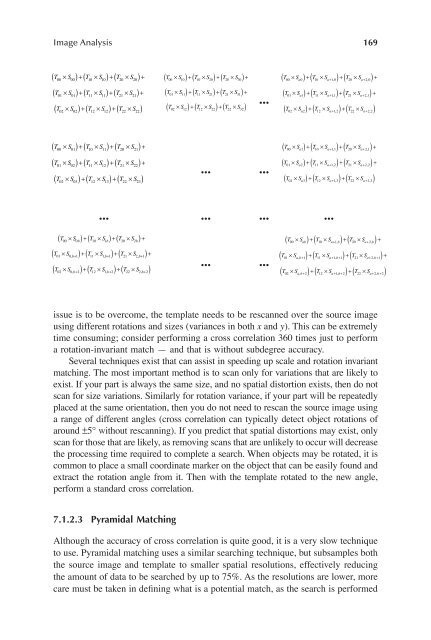Image Acquisitionand Proces
Create successful ePaper yourself
Turn your PDF publications into a flip-book with our unique Google optimized e-Paper software.
<strong>Image</strong> Analysis 169<br />
( T00 ¥ S00 ) + ( T10 ¥ S10 ) + ( T20 ¥ S20<br />
) +<br />
( T00 ¥ S10 ) + ( T10 ¥ S20 ) + ( T20 ¥ S30<br />
) +<br />
( T00 ¥ Sa0 ) + ( T10 ¥ Sa+ 1, 0 ) + ( T20 ¥ Sa+<br />
2,<br />
0 ) +<br />
( T01 ¥ S01) + ( T11 ¥ S11) + ( T21 ¥ S21) +<br />
( T02 ¥ S02 ) + ( T12 ¥ S12 ) + ( T22 ¥ S22<br />
)<br />
( T01 ¥ S11) + ( T11 ¥ S21) + ( T21 ¥ S31) +<br />
( T02 ¥ S12 ) + ( T12 ¥ S22 ) + ( T22 ¥ S32<br />
)<br />
•••<br />
( T01 ¥ Sa 1) + ( T11 ¥ Sa+ 1, 1) + ( T21 ¥ Sa+<br />
2,<br />
1) +<br />
( T02 ¥ Sa2 ) + ( T12 ¥ Sa+ 1, 2 ) + ( T22 ¥ Sa+<br />
2,<br />
2 )<br />
( T00 ¥ S01) + ( T10 ¥ S11) + ( T20 ¥ S21) +<br />
( T00 ¥ Sa 1) + ( T10 ¥ Sa+ 1, 1) + ( T20 ¥ Sa+<br />
2,<br />
1) +<br />
( T01 ¥ S02 ) + ( T11 ¥ S12 ) + ( T21 ¥ S22<br />
) +<br />
( T02 ¥ S03 ) + ( T12 ¥ S13 ) + ( T22 ¥ S23<br />
)<br />
•••<br />
•••<br />
( T01 ¥ Sa2 ) + ( T11 ¥ Sa+ 1, 2 ) + ( T21 ¥ Sa+<br />
2,<br />
2 ) +<br />
( T02 ¥ Sa3 ) + ( T12 ¥ Sa+ 1, 3 ) + ( T22 ¥ Sa+<br />
2,<br />
3 )<br />
••• ••• ••• •••<br />
( T00 ¥ S0 b) + ( T10 ¥ S1 b) + ( T20 ¥ S2<br />
b) +<br />
( T00 ¥ Sab ) + ( T10 ¥ Sa + 1, b ) + ( T20 ¥ Sa + 2,<br />
b ) +<br />
( T01 ¥ S0, b+ 1) + ( T11 ¥ S1 , b+ 1) + ( T21 ¥ S2,<br />
b+<br />
1) +<br />
( T02 ¥ S0, b+ 2 ) + ( T12 ¥ S1 , b+ 2 ) + ( T22 ¥ S2,<br />
b+<br />
2 )<br />
•••<br />
•••<br />
( T01 ¥ Sab , + 1) + ( T11 ¥ Sa+ 1, b+ 1) + ( T21 ¥ Sa+ 2,<br />
b+<br />
1) +<br />
( T02 ¥ Sab , + 2 ) + ( T12 ¥ Sa+ 1, b+ 2) + ( T22 ¥ Sa+ 2,<br />
b+<br />
2)<br />
issue is to be overcome, the template needs to be rescanned over the source image<br />
using different rotations and sizes (variances in both x and y). This can be extremely<br />
time consuming; consider performing a cross correlation 360 times just to perform<br />
a rotation-invariant match — and that is without subdegree accuracy.<br />
Several techniques exist that can assist in speeding up scale and rotation invariant<br />
matching. The most important method is to scan only for variations that are likely to<br />
exist. If your part is always the same size, and no spatial distortion exists, then do not<br />
scan for size variations. Similarly for rotation variance, if your part will be repeatedly<br />
placed at the same orientation, then you do not need to rescan the source image using<br />
a range of different angles (cross correlation can typically detect object rotations of<br />
around ±5∞ without rescanning). If you predict that spatial distortions may exist, only<br />
scan for those that are likely, as removing scans that are unlikely to occur will decrease<br />
the processing time required to complete a search. When objects may be rotated, it is<br />
common to place a small coordinate marker on the object that can be easily found and<br />
extract the rotation angle from it. Then with the template rotated to the new angle,<br />
perform a standard cross correlation.<br />
7.1.2.3 Pyramidal Matching<br />
Although the accuracy of cross correlation is quite good, it is a very slow technique<br />
to use. Pyramidal matching uses a similar searching technique, but subsamples both<br />
the source image and template to smaller spatial resolutions, effectively reducing<br />
the amount of data to be searched by up to 75%. As the resolutions are lower, more<br />
care must be taken in deÞning what is a potential match, as the search is performed



